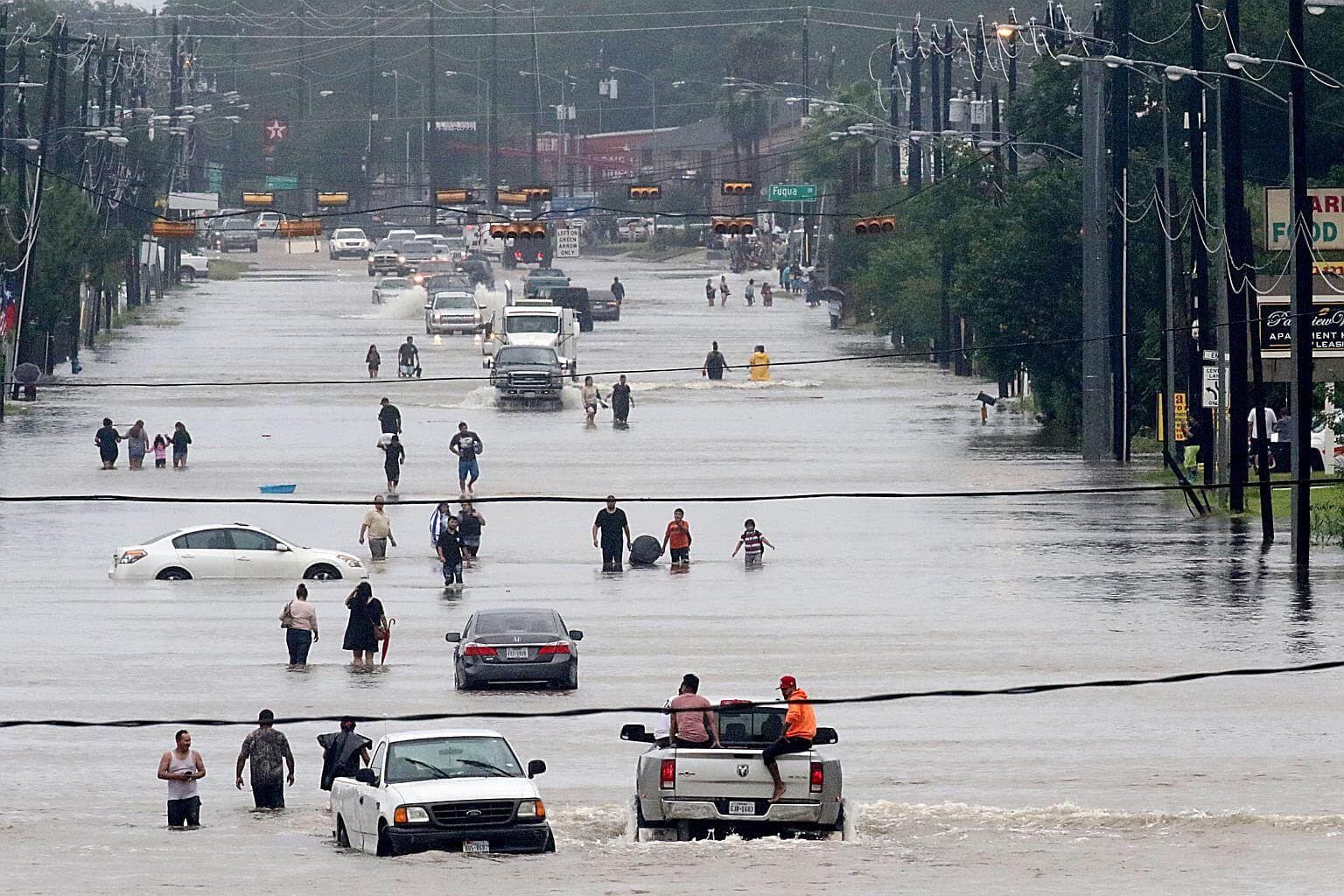Global warming to unleash more rains, exposing millions more to floods
Sign up now: Get ST's newsletters delivered to your inbox

People walking through the flooded waters of Telephone Road in Houston during tropical storm Harvey on Aug 27, 2017.
PHOTO: AFP
Follow topic:
ROME (REUTERS, AFP) - Unless countries urgently boost their flood defences, millions more people will be at risk from river flooding in the next 20 years as global warming increases the likelihood of severe rainfall, scientists said on Wednesday (Jan 10).
In Asia, the numbers at risk will more than double to 156 million, up from 70 million, with India, China and Indonesia among the worst-affected countries, according to a study by the Potsdam Institute for Climate Impact Research.
Pakistan, already prone to flooding, "will observe almost a doubling in high-end flood risk," with 11 million people at risk of floods unless protective measures are taken by 2040.
The numbers at risk in South America also will double, to 12 million, and Africa will see a rise to 34 million facing flooding threats, up from 25 million, the researchers said.
However, the actual number of people at risk is likely to be higher than the scientists' predictions, as the estimates do not take into account population growth or more people moving to areas at risk of flooding, scientists said.
In a new study published in the journal Science Advances, researchers calculate how much more flood protection will be needed to keep the risks of high-end floods constant in the next 25 years.
Unless actions are taken - such as enhancing dykes, boosting building standards, relocating settlements and managing rivers - the number of people affected by devastating floods could skyrocket, warns the report, based on models that are 10 times more precise than commonly used climate computer simulations.
The United States and parts of Europe also will need to make major investments in flood protection - such as improving river dykes, river management and building standards, or relocating people - to prevent a rise in the numbers of people facing flooding.
"More than half of the United States must at least double their protection level within the next two decades if they want to avoid a dramatic increase in river flood risks," Sven Willner, from the Germany-based Potsdam Institute, said in a statement.
"In South America the number of people affected by flooding risks will likely increase from six to 12 million, in Africa from 25 to 34 million," the study said.
In Germany the number of people affected is projected to rise seven-fold, from 100,000 to 700,000.
In North America, it could rise from 100,000 to one million.
Global warming increases the risk of flooding because the amount of rain that can fall during an extreme downpour "increases exponentially" as temperatures rise, Anders Levermann, also of the Potsdam Institute, said in an interview.
When more heat-trapping pollutants surround the Earth, more moisture is held in the air, leading to more rainfall.
Cutting these emissions is crucial to reducing flood risks for future generations.
Global temperatures have already risen by more than 1 deg C above pre-industrial levels, and are expected to continue rising.
Countries committed in 2015 to try to hold global temperature rise to "well below" 2 deg C, but the world is currently on track for more than 3 deg C of warming, a level expected cause much more extreme and unpredictable weather, and to cause worsening crop failures and more migration.
"The findings should be a warning to decision-makers," added Levermann.
"Doing nothing will be dangerous."
Although river floods may seem less dramatic than hurricanes and cyclones, they can inflict serious damage.
Last year, Peru experienced its worst flooding in decades, causing up to US$9 billion (S$12 billion) in damage. South Asia in 2017 suffered its worst monsoon flooding in a decade, which killed more than 1,400 people, left hundreds of villages submerged and drove tens of thousands of people to relief camps.
Disaster management officials in the region said although flooding is normal during the monsoon months, they received a whole year's rain in just a few days.
But the question of how best to protect people from river floods is a complex one.
"It's not that straightforward to think if only we built dykes and levees along the rivers ... then the world will be a safe place," said Richard Klein, a senior research fellow at the Stockholm Environment Institute.
Building flood protection "will also have an effect on food production and it will increase the risk of particularly high magnitude events", he told the Thomson Reuters Foundation.
In Bangladesh for example, regular and often predictable floods dump a fertile layer of river sediment on fields, one reason the country is self sufficient in rice, Klein said.
"People tend to pick up their stuff, move to higher ground and come back when the water's gone, and (they) benefit from the fertile soil that they have," he said.
Building infrastructure to contain floodwaters can also give people a false sense of security, so they are more likely to build in areas still at risk of flooding after a severe downpour. "That's not to say one shouldn't protect people, but ... simply protecting ... has consequences," he said.

